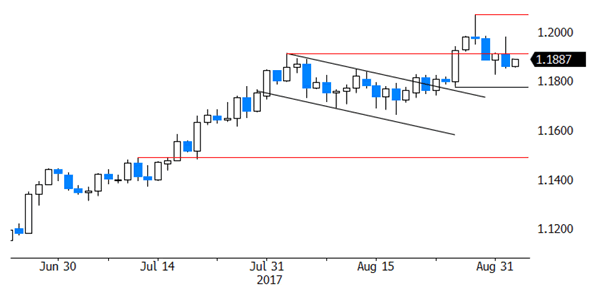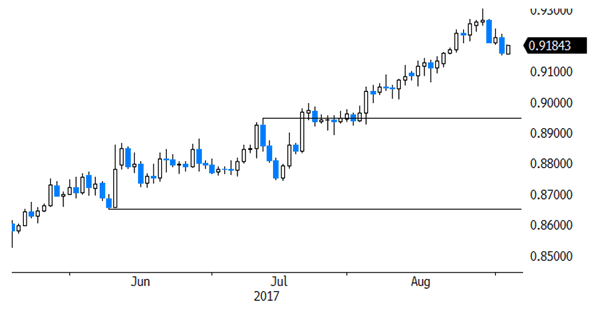Sunrise Market Commentary
- Rates: Risk aversion after North Korean nuclear test
Risk aversion dominates Asian trading this morning (positive for core bonds) after Pyongyang’s latest nuclear test which triggered an aggressive verbal response by the US. Such geopolitical events had a rather short timestamp on markets of late, but the absence of US traders (Labour Day Holiday) and eco data suggests that it will be today’s only trading theme. - Currencies: Risk-off sentiment to block USD rebound.
On Friday, the dollar easily dismissed a mediocre US payrolls report, suggesting that the recent USD decline was exhausted. During the weekend, geopolitical tensions returned to the forefront. Of late, a global safe haven bid didn’t help the dollar much. So, a further USD comeback might not be that easy.
The Sunrise Headlines
- US equities closed modestly higher as weak payrolls were fast digested. Asian equities started the week on a weak footing after North Korea tested a powerful nuclear bomb. The yen strengthened, but already lost part of the gains. Gold is moderately higher, but off the lows.
- North Korea said it successfully tested a hydrogen bomb with “unprecedentedly big power” that can be loaded onto an intercontinental missile, in its first nuclear test under US Trump’s presidency.
- US defence secretary Mattis, who was a rather dovish voice inside the administration recently, said the US will answer any threat from the North with a “massive military response”.
- US Congressmen return from summer recess Tuesday with the eyes of bond traders squarely upon them. Among their pressing tasks: increase America’s borrowing authority and prevent an unprecedented default before Sep 29.
- Moody’s raised the outlook on Portugal’s Ba1 bond rating to positive from stable as growth continues to show resilience and the debt structure improves. S&P confirmed Sweden’s AAA rating stable outlook and Fitch Germany’s AAA.
- Russia is likely to back a further extension of the OPEC agreement cutting oil output, the country’s deputy prime minister said. Crude traded volatile, but sideways on Friday and is slightly lower overnight.
- The eco calendar is uneventful and US markets are closed for Labour Day today. Later this week focus is on ECB meeting (Thursday), US Congress (debt ceiling, government shutdown) and US Non-manufacturing ISM (Wednesday)
Currencies: Risk-Off Sentiment To Block USD Rebound
Dollar cautiously softer as sentiment turns risk-off
On Friday, the US payrolls disappointed. The dollar instantaneously lost ground, but losses were rapidly erased. EUR/USD spiked from about 1.1920 to 1.1980, but soon turned back south. The dollar received additional support for a strong US manufacturing ISM. Similarly, USD/JPY dropped temporary to the mid 109 area, only to return north of 110. Investor doubts on the statistical accuracy of the August Payrolls might have played a role in the modest USD reaction to the report. The USD price action suggest that the recent setback of the USD is exhausted. EUR/USD finished the session at 1.1860 (from 1.1910). USD/JPY ended at 110.25 (from 109.989).
During the weekend, geopolitical risk returned to the forefront as North Korea tested a new nuclear bomb on Sunday. Major regional equity indices are losing about 1%. China outperforms. USD/JPY opened sharply lower in the 109.25 area, but the yen already returned an important part of the earlier gains (currently 109.80 area). The North Korea tensions have little impact on EUR/USD. It holds very tight range near the 1.1880 level.
Today, US markets are closed today and the EMU calendar is uneventful with only the Sentix investor confidence for September and the PPI for July. Later this week, most attention goes to Thursday’s ECB meeting, the return of US Congress (Tuesday) and many Fed speeches ahead of the black period. The rumour mill about the ECB meeting is running hot. ECB Nowotny downplayed euro strength, but unnamed ECB sources suggested that euro strength is making the ECB Council nervous. Other sources said that a decision on the APP programme might be delayed to October or even to December. The stronger euro isn’t going to help inflation higher, but growth is above trend, which implies that underlying inflation will at some point start rising. This puts the ECB in a difficult position. The US House will have to hurry up with the vote on a continuing spending bill to avert a government shutdown early October and on the debt ceiling. Regarding US data, we expect the Non-manufacturing ISM to be strong as was the manufacturing one.
Sentiment on the dollar improved slightly after the post Jackson-Hole sell-off. However, for now, the US currency didn’t regain any technically relevant level against the euro or the yen. So, the jury is still out whether a sustained USD rebound is on the cards. The data might be slightly USD supportive A (moderate) risk-off sentiment didn’t help the dollar much of late . Therefore, we start the week with a neutral bias.
If EUR/USD would fall below the 1.18/1.1775 area, it would suggest that more downside short-term. For such a move, the USD needs good data and higher US yields. On the euro side of the story, Draghi has to convince markets that low inflation is enough a reason for the ECB to maintain a loose monetary policy. On the topside, the 1.2070 correction top remains the first reference.
A downward correction in core (US and European) yields supported the yen in August. USD/JPY declined from mid-114 mid-July and came within reach of the key 108.13 range bottom, but the support did its job. We maintain the working hypothesis that this level won’t be broken as a lot USD bad news is discounted. A cautious buy-on-dips (with stop-loss protection below 108) may be considered. USD/JPY needs to regain the 110.95 level to suggest an improved upside momentum. Such a break might be difficult if sentiment would turn risk-off.

EUR/USD: dollar ‘resists’ disappointing payrolls report, but no technical signal of a sustained rebound of the US currency yet
EUR/GBP
EUR/GBP drops below 0.92
Sterling traded sideways in the Friday’s morning session, ignoring an unexpectedly strong Manufacturing PMI. The improvement was broad-based suggesting that the weak pound is starting to help the economy. EUR/GBP kept close to the 0.9210 going towards the US payrolls release. Strange enough, cable didn’t return gains against the dollar after the weaker payrolls unlike EUR, JPY, …. This resulted in a significant decline of EUR/GBP. The pair closed the session at 0.9159 (from 0.9211). Cable closed the session at 1.2951 (from 1.2930).
Today, only the UK construction PMI will be published. A big deviation from consensus is needed to inspire any GBP reaction. During the weekend, there were diverging comments on the poor progress in the Brexit negotiations. UK Davis dismissed rumours that the UK would consider to pay an exit bill of about £ 50 bln. The lack of process in the Brexit talks is a negative for sterling. However, as is the case for the dollar, the recent sterling decline (especially against the euro) looks exhausted. So, some consolidation ahead of the ECB meeting might be on the cards.
From a technical point of view, EUR/GBP cleared the 0.8854/80 resistance (top end June), opening the way for further gains. The move was the result of euro strength. Simultaneously, UK price data were soft enough to keep the BoE sidelined. MT, we maintain a buy EUR/GBP on dips approach as we expect the combination of relative euro strength and sterling softness to persist. The 0.9415 ‘flash-crash spike’ is the next target on the charts. However, wait for a correction, e.g. to the technical support in the 0.88/89 area, to sell sterling again versus the euro.

EUR/GBP: sterling extends gradual rebound, despite BRexit stalemate












